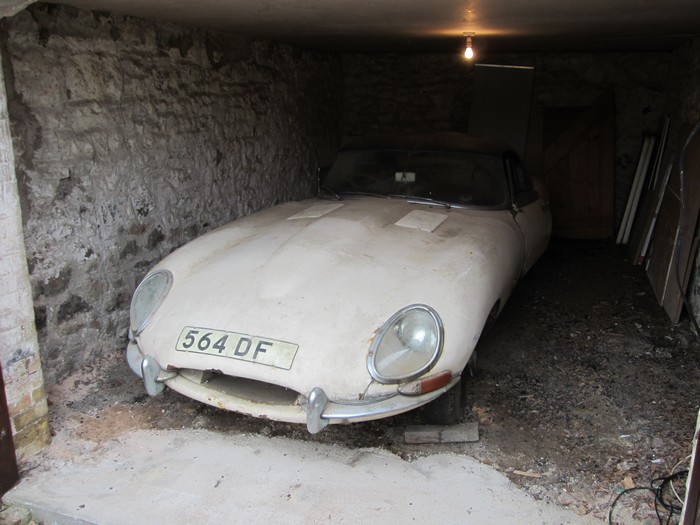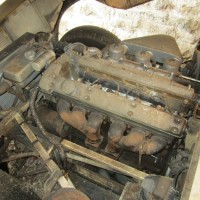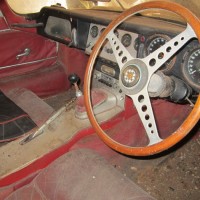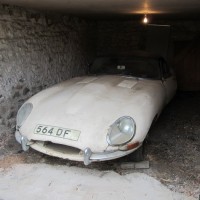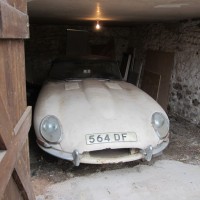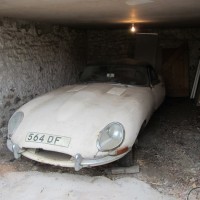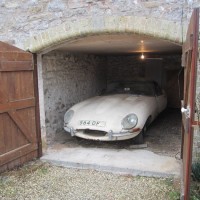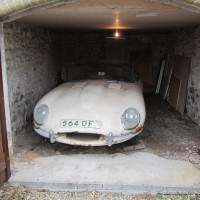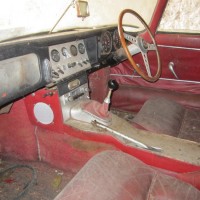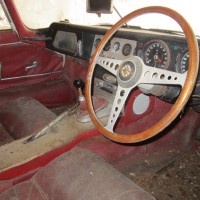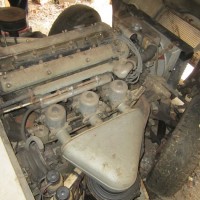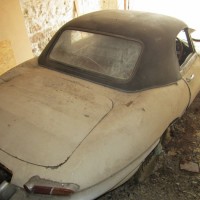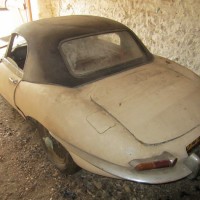Introduced in 3.8-liter form in 1961, the Jaguar E-type caused a sensation when it appeared, with instantly classic lines and a 150-mph top speed. Its design owed much to that of the racing D-type: a monocoque tub forming the main structure, while a tubular space frame extended forward to support the engine. The latter was the 3.8-liter, triple-carburetor S unit first offered as an option on the XK 150. The E-type’s performance did not disappoint: first, because it weighed around 500 pounds (227 kg) less than the XK 150 and secondly because aerodynamicist Malcolm Sayer used experience gained with the D-type to create one of the most elegant and efficient shapes ever to grace a motor car.
However, taller drivers could find the interior somewhat lacking in space, a criticism addressed with the introduction of footwells (and other, more minor modifications) early in 1962. But of all the versions of Jaguar’s long-lived and much-loved sports car, it is the very early “flat floor” 3.8-liter cars built prior to February 1962 which, for many enthusiasts, remain the most desirable.
Dating from the first few weeks of production, this vehicle is one of the earliest surviving right-hand-drive Jaguar E-type roadsters (the chassis number sequence commenced at 850001). There can be few of its kind left in such original, unrestored condition.
Our subject car was purchased by the current owner in February 1965 from Jaguar dealer AJ Beal of Exeter and used regularly until about 30 years ago. Taken off the road, it was stored outside, covered over, for the first five years and then garage-stored until today. The provision of Koni shock absorbers and a hard top are departures from factory specification, while the footwell and rear bulkhead have been altered to increase leg room. The original hood is included in the sale, and the car also comes with owner’s manual, data plate, old-style logbook and Swansea V5 document. Offered for restoration and sold strictly as viewed, 564DFJ represents a wonderful opportunity for the dedicated E-type enthusiast.
SCM Analysis
Detailing
| Vehicle: | 1961 Jaguar E-Type Barn Find |
| Years Produced: | 1961 |
| Number Produced: | 91 like this one |
| Original List Price: | $5,595 |
| SCM Valuation: | $65,000-$85,000 |
| Tune Up Cost: | $400 |
| Chassis Number Location: | Plate on top of right footwell box in engine bay |
| Engine Number Location: | Right side of engine block atop oil filter mounting flange under Jaguar logo |
| Club Info: | The E-type Club |
| Website: | http://www.e-typeclub.com |
This car, Lot 381, sold for $168,791, including buyer’s premium, at Bonhams’ RAF Museum Sale at Hendon, North London, U.K., on April 29, 2013.
This is the 60th E-type off the production line, and it has 65,000 miles from new. It was expected to make $30,000–$45,000, but it blew that by four times — to no real surprise.
It was completely rotten, with the doors rusted out, crude repairs to the backs of the sills, modified floor pans and everything crystallized with a layer of dust or rust.
The very 1970s Pirelli Cinturato tires date it to when it was last used — yet remarkably, the seat leather appeared to be mold- and mildew-free, bearing light wear and creasing commensurate with the mileage.
The instruments were all there, although their bezels (rims) had rusted. The engine was lightly corroded, but under the outside-lock hood everything was complete and original, down to the large airbox and filter housing and the bellows-type Kelsey-Hayes brake servo.
Untouched restoration projects are all the rage right now. So many early E-types (and Astons, and others) suffered poor restorations earlier in their lives, when they were just old cars that didn’t warrant spending large sums of money. So, few of them can be described as truly original. In fact, not even this one, but it’s a detail, as we shall see.
A big bid, big resto bill
The man who bought this was the initial bidder who showed his hand at £40k ($61,400), and then kept his powder dry and snuck in with the winning £90k ($138,500) bid when proceedings tailed off. The car was immediately trucked to leading E-type restorer Classic Motor Cars of Bridgnorth, U.K., which recently unfolded and resurrected the mangled Lindner-Nocker Lightweight, as well as 1 VHP, the first right-hand-drive coupe off the production line.
Top restorers’ work is never cheap, and I’d estimate that on top of the huge money spent to buy it — which would get you a very nice restored car, remember — at least another $250k needs pouring into this to make it perfect. That’s still cheaper than restoring a Superleggera Aston.
The point about it, the thing that makes this car so desirable, is that it is a near-virgin canvas, untouched apart from the ravages of time and atmosphere, and with every original detail present and correct, including jack and tool kit.
The hard top is a grotty Lenham aftermarket item. Nick Goldthorp, Classic Motor Cars’ managing director, said, “The amazing thing about this E-type is that every original part is there, although in a very rusty and corroded condition.
“We can save the tub,” Goldthorp said. “The front and rear bulkheads are usable, and the boot floor is savable. It’ll want floors and sills, but that’s normal. Someone had crudely added footwells — copying what Jaguar did — which happened to a lot of the early cars. The bonnet is original and usable, too, though it’s full of 1970s filler.”
The new owner’s plan
Chris Anderson bought the car at Hendon and he said, “Apart from the battery and tires, it is totally original, making it currently one of the most original E-types in the world. I’ve been looking for one for ages and this was the perfect opportunity. It is also one of only 91 outside-bonnet-lock, right-hand-drive open two-seaters ever built.
“I recently read that it is thought that only one-fifth of those 91 cars survive today, and some of those have been badly restored, or converted to race cars,” Anderson said. “That makes 564DFJ not only one of the most original E-types, but also one of the few cars that represent the early semi-prototypes that were the genus of the E-type line.”
This restoration is going to be taken to an almost-molecular level, as CMC has been instructed to restore and re-use every nut, bolt and hose clip, at a cost of something like $50 a clip, which Anderson admits wouldn’t make financial sense in the usual scheme of things.
“But putting new ones on would be wrong, and that means it will remain one of the most original E-types — something I would not be doing if cost instead of preserving history was the issue,” Anderson said.
But this car’s not going to be hermetically sealed once returned to its former glory. Anderson plans to drive it.
“I’m lucky to have another early flat-floor car that’s been driven loads — they don’t last if they’re left stationary,” Anderson said.
So there we go. A proper car bought by a proper bloke who really understands the issues, with a mountain of work ahead — to be carried out meticulously at a top restorer. But although the money’s irrelevant, compared with the prices of top early restored E-types, the new owner knows the car would just about wash its face if — hypothetically — it came to sale.
That’s not so important, but surely the wait to drive it will be worth it. Let’s call it extraordinarily well sold, and thoughtfully well bought ?
(Introductory description courtesy of Bonhams.)
